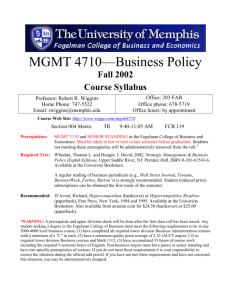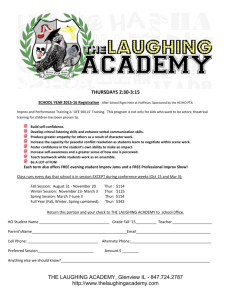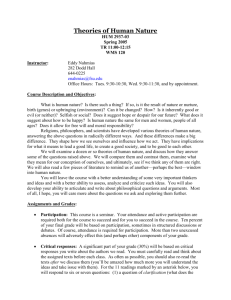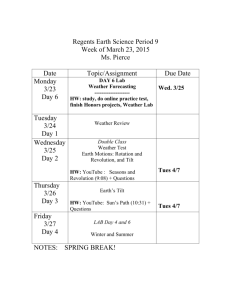MGMT 7160—Seminar in Business Policy
advertisement
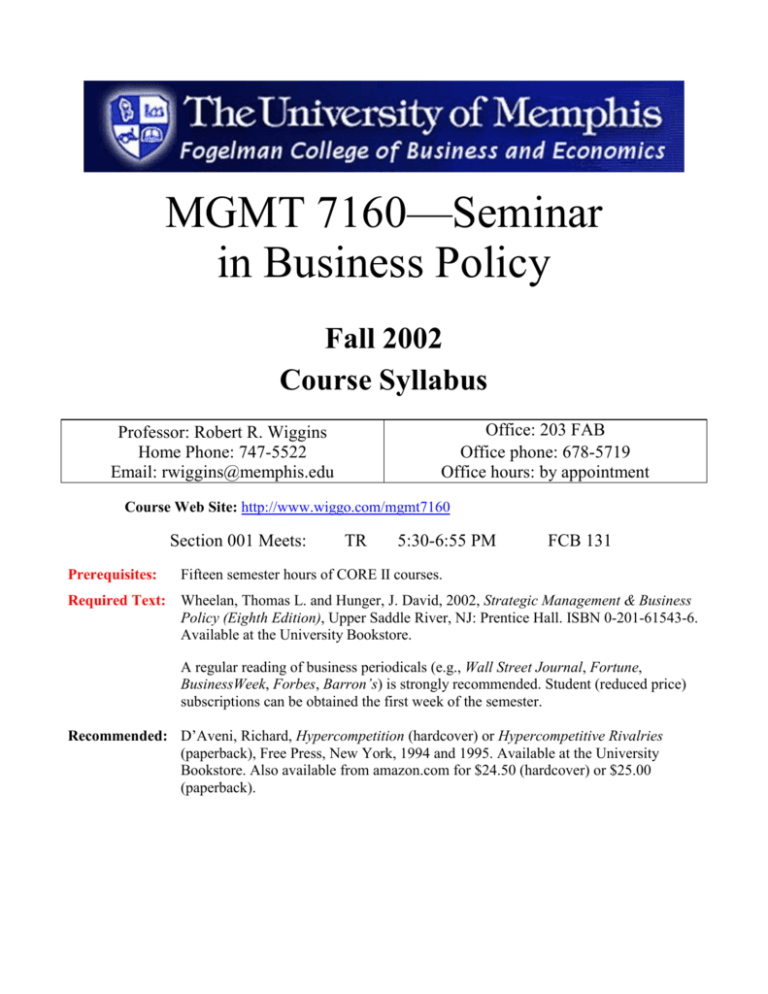
MGMT 7160—Seminar in Business Policy Fall 2002 Course Syllabus Office: 203 FAB Office phone: 678-5719 Office hours: by appointment Professor: Robert R. Wiggins Home Phone: 747-5522 Email: rwiggins@memphis.edu Course Web Site: http://www.wiggo.com/mgmt7160 Section 001 Meets: Prerequisites: TR 5:30-6:55 PM FCB 131 Fifteen semester hours of CORE II courses. Required Text: Wheelan, Thomas L. and Hunger, J. David, 2002, Strategic Management & Business Policy (Eighth Edition), Upper Saddle River, NJ: Prentice Hall. ISBN 0-201-61543-6. Available at the University Bookstore. A regular reading of business periodicals (e.g., Wall Street Journal, Fortune, BusinessWeek, Forbes, Barron’s) is strongly recommended. Student (reduced price) subscriptions can be obtained the first week of the semester. Recommended: D’Aveni, Richard, Hypercompetition (hardcover) or Hypercompetitive Rivalries (paperback), Free Press, New York, 1994 and 1995. Available at the University Bookstore. Also available from amazon.com for $24.50 (hardcover) or $25.00 (paperback). Course Description and Overall Goal: This course is designed to present strategic management from the point of view of the practicing general manager. It focuses on specific knowledge and skills that are required to understand strategy and the process by which it is developed in business organizations, and provides information on the situation and context in which strategy is formed and implemented. The course will integrate knowledge and skills developed in the core courses of the MBA program, but that is not its only goal. Specific new information about the activities and skills of general managers will be presented. Students are expected to combine knowledge from other courses with information presented here to develop sophisticated interpretations and analyses of actual business problems and opportunities. The course contains a substantial writing component. Students will prepare written business case analyses on both an individual basis and a group basis, and business case presentations on a group basis. The expected level of quality and professionalism of the content and presentation of these cases will be that used in actual business organizations. Much managerial communication is verbal. Therefore, class discussion of lecture and case materials forms a substantial portion of the grade for this course. The principal objective of the course is for students to learn important facts and procedures about the strategic management process, while developing an understanding that strategy (and the jobs of those who formulate and implement strategy) is a highly uncertain activity in which only careful thought, sensitivity to the managerial environment, and creativity will succeed in the long run. Course Learning Objectives: 1. Development and reinforcement of a general management point of view—the capacity to view the firm from an overall perspective in the context of its environment. 2. Development of an understanding of fundamental concepts in strategic management: the role of the general manager; the levels and components of strategy; competitive analysis; the industrial organization perspective; the resource-based view of the firm; and organizational evolution. 3. Understanding of the influence of global competition on firm strategy and performance. 4. Detailed analysis and discussion of important social and ethical issues faced by managers. 5. Synthesis of the knowledge gained in previous courses and understanding what part of that knowledge is useful to general managers. 6. Development of an awareness of the impact of the economic, social, demographic, technological, and the political, legal and regulatory sectors of the firm’s external environmental on business and corporate strategy. 7. Practice in working out business strategies and implementation plans. 8. Development of habits for orderly, analytical thinking and skill in reporting conclusions effectively in both written and oral form. 9. Familiarity with some of the practical realities of running different types of businesses. Course Assignments and How They Are Evaluated Performance evaluation will be based on student performance in six types of activities: class participation, individual case analysis, group case analysis, group presentation, mid-term examination, and homework. Class Participation -- 20% of the grade Attendance (on time) is required and is a component of the participation grade. In a typical class, one or more students will be asked to start the class by answering a specific question or discussing a specific issue. A thoughtful reading of the chapter or case assigned for that class meeting should be sufficient to handle these leadoff discussions. As a group, we will then discuss the day’s assignment to develop a fuller understanding of the issues presented. Voluntary participation in discussion of lecture or case issues is an important part of this process and an important part of your class participation grade. Please raise your hand to obtain recognition before speaking. Class participation grades are based on the instructor's assessment of the student’s in-class contribution to the discussion. The bases for this assessment include the following: 1. Are the points made relevant to the discussion? Are they linked to the comments of others? 2. Do the comments add to our understanding of the lecture or case discussion? 3. Do the comments show careful reading and understanding of the text and/or case? 4. Does the participant distinguish among different kinds of data (that is facts, opinions, beliefs, concepts, etc?) 5. Is there a willingness to “take a chance” in the discussion, or are the comments “safe”? Examples of “safe” comments: (a) repetition of text or case facts without analysis; (b) repetition or seconding of a colleague’s conclusions or comments. Homework -- 10% of the grade You are required to submit a daily “homework” assignment on any twenty out of the twenty-four class meetings between August 29 and November 26. The content of the daily homework assignment will vary depending on the class content for the day it is due. 1. On days when a book chapter or book is to be discussed, then the assignment is to either (a) include a brief set of two or three original thought-provoking discussion questions (no more than six sentences total) about the chapter or (b) to provide an example (either positive or negative) of a company and situation currently in the news that illustrates one or more of the concepts in the chapter with a brief summary of the situation and how the concepts from the chapter are confirmed or denied (include a copy of an article from a business publication if possible). 2. On days when a case is to be discussed, then the assignment is to provide a brief statement (again, no more than six sentences total) about what you think the company in the case study should do, and why. If you are writing up the case for that day, you should briefly summarize your recommendations. In either case, the entire daily homework assignment should be limited to one typewritten page. Handwritten or late assignments will not be accepted. Note that the word “brief” is emphasized in the descriptions above. These assignments should be able to be completed in at most 10 to 15 minutes. Midterm Examination -- 10% of the grade A midterm examination consisting of multiple choice, true/false, and short essay questions will cover the material in the strategy formulation portion of the textbook (Wheelen & Hunger chapters 1-7) as well as 4 Arena analysis from the D’Aveni book, Hypercompetition. Students are expected to know Porter’s five forces, the elements of the value chain, D’Aveni’s 4 arenas, and all other relevant material. Individual Case Analysis -- 20% of the grade After the first class meeting, you will be expected to choose one case study for your individual case analysis report. A preference sheet for the case analysis reports is attached, and you will be expected turn it in by the fourth class meeting. Coordinate your individual preferences with your team preferences. Each member of a team will be assigned a different case. When the preference sheets have been turned in, I will assign the cases based on your preferences and distribute copies to all students in the course. The individual case analysis report constitutes 20% of your overall course grade. The individual case analysis report consists of two parts, a strategic audit as described in the textbook (attached as an appendix), and an executive summary. The executive summary should be around seven to ten pages of double-spaced text, with charts and figures included where appropriate. Brevity is important. Your individual case analysis reports are due at the beginning of the class when the case is to be discussed. Be ready to be a major participant in the case discussion. You will not be graded separately on the discussion, although it will count as part of your class participation grade. You have the option of addressing the case as written, as of the time of the case, or of doing a dynamic case analysis as the teams will be required to do. Since dynamic case analysis requires much more time and effort, I would recommend that for the individual case you choose to perform your analysis as of the time of the case. But the choice is yours. See General Requirements for Case Analyses and Dynamic Case Analysis in the next section. Team Case Analysis -- 20% of the grade A preference sheet for the case analysis reports is attached, and you will be expected turn it in by the fourth class meeting and indicate (a) which cases your team would prefer to write and (b) which cases you would prefer to write individually. When the preference sheets have been turned in, I will assign the team cases based on your preferences and distribute copies to all students in the course. The written team case analysis reports constitutes 20% of your overall course grade. I expect a much higher quality of writing from the team cases. The teams are required to do a dynamic case analysis as explained in the next section. The companies from the cases must be studied as of today, not as of the time of the case. The team case analysis reports should include a complete strategic audit, as described in the textbook, as well as an executive summary (seven to twenty pages of double-spaced text), with charts and figures included where appropriate. But again, brevity is important. Team Case Presentation -- 20% of the grade In addition to the written case analysis, each team will prepare a brief (15 to 20 minute) formal presentation. This presentation will follow the general class discussion. Be aware that several of your fellow students will also have done the case analysis on an individual basis, and everyone in the class (including the professor and any guests) will be free to ask questions following your presentation. Your handling of questions will be part of the grade for the presentation. One purpose of your presentation is to update the class as to what has transpired with the company and its industry since the time of the case, and this would be a good place to start your presentation. Then you will present your analysis and recommendations for solving the current major problem or issue facing the company. As in the real world, you are responsible for being completely current. If latebreaking news affects your problem or recommendations, you need to incorporate it into your presentation. Each team member must participate in the formal presentation. Your presentation should be in PowerPoint form, and presented using the classroom computer facilities. You should also be prepared with backup transparencies in case there are problems with the computer or the projection system. You should also be prepared to continue your presentation if the overhead projector also fails. The group presentation constitutes 20% of your overall course grade. The content of the presentation will be one-fourth (25%) of the grade. The quality of the presentation will be one-fourth (25%) of the grade. Your individual presentation style will be one-half (50%) of the grade. General Requirements for Case Analyses Approach the assignment as though you are a management consultant hired by the management of the company in the case to solve their problem. First, you must determine what the problem is. Then recommend an action plan for the company to follow. The case analysis report is your formal report to the company’s management. You may assume they know the facts of the case, and do not waste their time repeating them. Also, since this report is to executives, be concise. Brevity is important. Get to the point, but be able to support your conclusions with any appropriate analysis. All case analysis reports are due at the beginning of the class when the case is to be discussed. Be prepared to discuss your individual report with the entire class. Do not prepare a formal presentation, but be ready to be a major participant in the case discussion. You will not be graded separately on the discussion, although it will count as part of your class participation grade. After the class discussion, the team assigned that case will formally present their update since the time of the case and their analysis and recommendations for the present time. The following is a suggested format for organizing your case analysis report executive summary. It is up to you to decide on an appropriate format for your specific case and your specific ideas. (1) Brief diagnosis or problem definition (about one paragraph, at most one page). What is the most important problem or set of problems facing the company? What area(s) is(are) the problem(s) in? Why is it important to solve? (2) Analysis of the problem (about two pages). What caused the problem? What evidence or analysis supports your interpretation? How does the problem connect with other areas of the company or other businesses? (3) Recommendations (about four pages). What course of action do you suggest? Be specific. How does your solution follow from your problem analysis? How will your plan eliminate the problem? How will it be implemented? Include an action plan. How much will your plan cost? Is it feasible? How will it be financed? What are the risks of your plan? What can go wrong? Include a risk analysis. How will other actors (competitors, unions, employees, governments, suppliers, etc.) react to your plan? (4) Strategic Audit Appendix (no page limits). A complete strategic audit, as described in the textbook. Include EFAS, IFAS, SFAS, SWOT, and TOWS matrices. How to avoid the most common pitfalls of case analysis: (1) Provide a clear definition of the problem. The case materials will overwhelm you with information. In a short case analysis paper, you cannot hope to address all of the company’s problems. Choose the one problem that you think is the most important. Choose your definition of the problem carefully, as the way you define the problem will determine the kinds of solutions you look for. If you define it as a marketing problem, you will seek marketing solutions. If production, production solutions. If finance, finance solutions. And so on. (2) Analyze, don’t summarize. Do not summarize the facts in the case. Your report is aimed at management, who know the facts. Your report will be graded by someone who knows the facts. Do not rehash facts from the case. You do want to, however, cite facts, information and statistics from the case when they are necessary to support your position. But make it clear how they are supporting your position. (3) Always perform financial analyses. Even if the problem doesn’t seem to involve finances, you won’t be sure unless you do the analyses. See Chapter 14 in Wheelen & Hunger, pp. 342-353, for some of the kinds of analyses that are appropriate. (4) Support your analysis, ideas, and recommendations with adequate evidence. Again, cite facts, information and statistics from the case to justify your analysis. (5) Make sure your recommendations address the problem you defined. Do not define one problem, then by the end of the analysis be recommending solutions to a different problem. (6) Give practical, specific, feasible action recommendations. Make your recommendations the central focus of your paper. (7) Consider the risks. No plan is foolproof. Anticipate and prepare for risks. (8) Don’t report every analysis you undertook. You’re making a recommendation. Use the analyses that support your recommendation. But see numbers (2), (3), and (4). (9) Don’t be wishy-washy. Yes, there may be multiple alternatives. Yes, you may mention them. But choose one recommendation and explain why it’s the best alternative. Dynamic Case Analysis Traditional case analysis, in which the reader is presented with all the information needed to develop a managerial context for strategic analysis, is an inadequate approach for conveying the managerial problems faced in environments in which technology and/or competition are moving a rapid pace—a situation characterizing more and more industries. In these environments, a sense of the pace and nature of change is required, and current (or near-current) information is desirable if the strategic analysis is to have any relevance to the real world. Thus, in this course, even though most of the selected cases were written as of 1996 to 1998, the written case will be merely the starting point for setting the context. In preparing a dynamic case, the first step for the reader is to thoroughly read and understand the issues in the case material in the book—including the industry analysis segment (if any). The reader should then use the case as a guide to generate an update by accessing the on-line and CD-ROM data bases available in the library as well as reviewing the current trade literature. Topics for updating would include technology developments, the current state of the economy--in general as well as in the target segment, a current status outline of the firm in question, changes in management or other key players, new product characteristics (including pricing), recent developments in competition, the status of the supplier and customer segment of the target segment, developments in government regulation, as well as forecasts in each of the foregoing areas. Key strategic events and issues should be identified in the update material and put into a summary form for discussion in class. Special attention should be paid to characterizing the nature and pace of technological and competitive change. Two of the characteristics that distinguish high technology environments from low technology environments are the pace and rhythm of change in the underlying technology and the pace and rhythm of competitive actions in bringing that technology to market, so these elements should clearly appear in a case update. Graphs, charts, summary statistics and diagrams that compress the data into readily comprehensible material are especially suitable for a case update. General Rules Regarding Written Work: 1.) Use a spelling checker. 2.) Minimal grammatical errors. These rules are firm because they replicate the conditions the student should expect to find in any wellrun business establishment. In general, professionally managed enterprises do not commit, nor accept, needless spelling or grammatical errors in written or presented materials. They diminish the quality of the company’s reputation for accuracy and attention to detail, and take attention away from the content of the message presented. General Information 1) Grade ranges: 90–100 = A; 80–89 = B; 70-79 = C; 60-69 = D; Below 60 = F. Grades on each of the six assignments will be weighted as specified above and summed to calculate your final grade. There will be no curve. 2) I will be fully prepared for every class and expect you to be the same. I sometimes call on students whose hands are not raised, and therefore request that you advise me before class if some emergency has made it impossible for you to prepare adequately for class discussion. 3) Class attendance is required at every class meeting. More than two absences will result in a deduction to the class participation grade of the student. If a student does miss a class, it is his or her responsibility to find out from classmates what materials were covered, what additional assignments were made, and what items may have been distributed in class. 4) The course has a web site at http://www.wiggo.com/mgmt7160 where I will be posting copies of all materials, including lecture slideshows (the day after the lecture). 5) I will attempt to learn your names as quickly as possible. However, to allow me to keep track of participation grades from the very beginning, I will be using a seating chart. Please sit in your assigned seats. If you do not, you will be marked absent. 6) Class will begin on time. You are expected to be in your seat and ready to begin the leadoff discussion at that time. Learn to be prompt. Showing up late to meetings shows a lack of respect, and will not help your career. Start getting used to it now, when all it can hurt is your grade. 7) Written work is due at the beginning of class on the day it is due. Late papers will be accepted only in the case of dire emergencies. 8) Study groups are acceptable for all assignments except the individual case analysis. It must be solely your own work and no discussion with other persons or collaboration of any kind is allowed on this assignment. 9) Please do not eat during class. 10) Hats and caps should not be worn in class. 11) All beepers and cell phones are to be turned off before entering the classroom and not turned back on until class is over. If your beeper goes off or your cellphone rings, it will hurt your participation grade. 12) No recording devices are permitted in class. 13) This class is “unplugged.” Notebook computers and handhelds can only be used for taking notes. Any other uses will hurt your participation grade. Schedule of Classes Date 8/27 Day Tues Subject Overview, distribution of syllabus, introductions. Basic Concepts of Strategic Management Corporate Government and Social Responsibility Environmental Scanning and Industry Analysis 8/29 9/3 Thur Tues 9/5 Thur 9/10 Tues 9/12 9/17 9/19 Thur Tues Thur 9/24 9/26 Tues Thur Case 2: Redhook Ale Brewery (1998) Strategy Formulation: Corporate Strategy W&H Case 32 W&H Ch. 6 10/1 10/3 Tues Thur W&H Case 21 W&H Ch. 7 10/8 10/10 Tues Thur Case 3: Kmart (2000) Strategy Formulation: Functional Strategy and Strategic Choice Case 4: Wal-Mart (2000) Hypercompetition 10/15 10/17 Tue Thur NO CLASS Midterm Examination 10/22 10/24 Tues Thur 10/29 10/31 Tues Thur 11/5 11/7 Tues Thur Case 5: Home Depot (2000) Strategy Implementation: Organizing for Action Case 6: Boeing (2001) Strategy Implementation: Staffing and Directing Case 7: Harley-Davidson (1998) Evaluation and Control 11/12 11/14 Tues Thur 11/19 11/21 Tues Thur 11/26 11/28 12/3 Tues Thur Tues Internal Scanning: Organizational Analysis Case Analysis Case 1: Carnival (1998) Strategy Formulation: Situation Analysis and Business Strategy Case 8: Apple Computer (2000) Strategic Issues in Managing Technology and Innovation Case 9: Cisco Systems (1998) Strategic Issues in Entrepreneurial Ventures and Small Businesses Case 10: Sun Microsystems (2000) NO CLASS Concluding Lecture Reading Tools Other W&H Ch. 1 W&H Ch. 2 W&H Ch. 3 W&H Ch. 4 W&H Ch. 14 W&H Case 17 W&H Ch. 5 W&H Case 23 D’Aveni Chapters 1-4 EFAS Matrix 5 Forces (Porter/BCG) Scenario Analysis (Porter/BCG) IFAS Matrix Value Chain (Porter/BCG) SFAS Matrix (EFAS + IFAS) TOWS Matrix Generic Strategies (Porter/BCG) Growth-Share Matrix (BCG) Position Matrix (McKinsey) TQM and CPR Pro Forma Analysis 4 Arenas (D’Aveni) New 7-S (D’Aveni) Fall Break W&H Chapters 1-7 W&H Case 24 W&H Ch. 8 D’Aveni (4 Arenas only) W&H Case 33 W&H Ch. 9 W&H Case 16 W&H Ch. 10 W&H Case 14 W&H Ch. 11 EVA (Stern Stewart) TRS (McKinsey & Co.) Balanced Scorecard (Harvard) R&D Life Cycle Life Cycle Matrix (Arthur Little) W&H Case 10 W&H Ch. 12 W&H Case 11 Thanksgiving MGMT 7160 Case Preference Sheet Name:____________________________________________________________________ Preferred Team: ____________________________________________________________ Please number your preferences from 1 (most preferred) to 10 (least preferred). Coordinate your choices with your team, as each member of a team will be assigned a different case individually, and team preferences should be the same for all team members. Individual Preferences Team Preferences ______ Case 1: Carnival (1998) ______ Case 1: Carnival (1998) ______ Case 2: Redhook Ale (1998) ______ Case 2: Redhook Ale (1998) ______ Case 3: Kmart (1998) ______ Case 3: Kmart (1998) ______ Case 4: Wal-Mart (2000) ______ Case 4: Wal-Mart (2000) ______ Case 5: Home Depot (2000) ______ Case 5: Home Depot (2000) ______ Case 6: Boeing (2001) ______ Case 6: Boeing (2001) ______ Case 7: Harley-Davidson (1998) ______ Case 7: Harley-Davidson (1998) ______ Case 8: Apple Computer (2000) ______ Case 8: Apple Computer (2000) ______ Case 9: Cisco Systems (1998) ______ Case 9: Cisco Systems (1998) ______ Case 10: Sun Microsystems (2000) ______ Case 10: Sun Microsystems (2000) If you have a compelling reason why you want a particular case, please explain: _________________________________________________________________________ _________________________________________________________________________ _________________________________________________________________________ Any additional information regarding your case preferences: MGMT 7160 Student Information Sheet Name:____________________________________________________________________ Concentration:_____________________________________________________________ Home Town:_______________________________________________________________ Undergrad Degree & School:__________________________________________________ Job?______ Doing What?____________________________________________________ What Company?________________________________________________________ How Long?____________________________________________________________ Other Work Experience:______________________________________________________ _________________________________________________________________________ _________________________________________________________________________ _________________________________________________________________________ Career Objective:___________________________________________________________ _________________________________________________________________________ _________________________________________________________________________ _________________________________________________________________________ Interesting Facts (hobbies, family, sports, other)___________________________________ _________________________________________________________________________ _________________________________________________________________________ _________________________________________________________________________ _________________________________________________________________________


